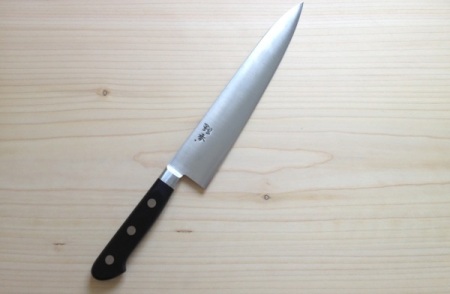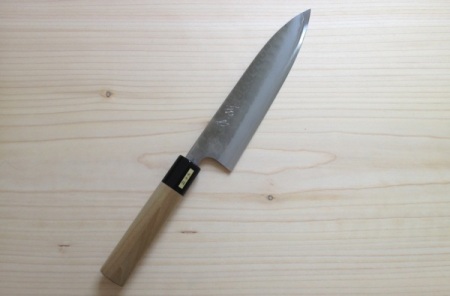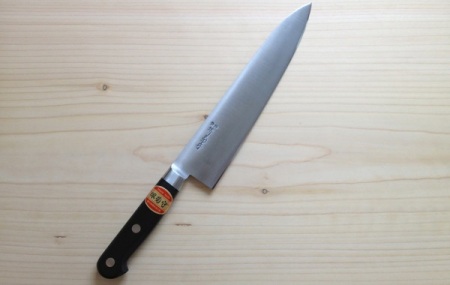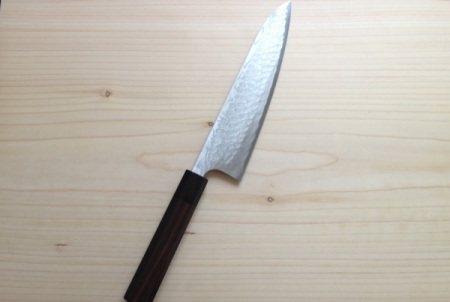After learning so much about how to pick a cutting board at Bernal Cutlery, I decided to ask Josh about the basics of choosing a chef’s knife. Bernal Cutlery primarily focuses on Japanese-style knives, but also carries new French knives as well as a selection of refurbished recent, vintage and antique knives from around the world.
Bernal Cutlery doesn’t carry the seven or eleven piece knife sets that are often found in cutlery stores, simply due to the fact that most people will never use seven or eleven different kinds of knives. Instead, Josh encourages purchasing the nicest possible chef’s knife that one can afford, and then building a knife kit around that central piece. If taken care of, a good chef’s knife can last more than ten years.
To the average home cook in search of a good chef’s knife, Josh recommends starting with a Japanese-style 210mm stainless steel blade. The alternative, carbon, requires more upkeep and care, as carbon blades are prone to rusting if left wet or with food on them (just ask Diane who almost cried when hers rusted on the drying rack because she hadn’t wiped the blade down properly). Also, if you are going to cut a lot of food that will cause the steel to react (think peaches, red onions or artichokes), wiping the blade clean during use will prevent the food from acquiring a slight metallic taste.
Many home cooks like myself enjoy the familiar weight of a heavy German knife. Japanese knives, on the other hand, tend to be thin and light, and may feel too delicate and unsteady for people used to more weight. Before testing recipes, I only used German chef’s knives. After using a Japanese-style chef’s knife during the day then returning home to a heavier German knife, I have decided to make the switch. I find that the Japanese knife moves easier, can slice thinner, and doesn’t leave my hand tired. For someone that cooks a few times a week, the difference between a heavy and a light knife may not be important, but for professionals or avid home cooks that spend hours chopping and slicing, a lightweight knife might make a big difference. Additionally, the thin, Japanese-style knives are great for fine vegetable work. The thinner blade does not wedge and crush the sides of vegetables, resulting in vegetable pieces with smoother surfaces, less oxidization and less discoloration. Josh, who encounters many fans of German knives, encourages his customers to give Japanese knives a chance by keeping a bag of carrots in the store for them to chop to their hearts content.
I asked Josh to recommend four knives for the average home cook, and to tell me a little about each:
This Ashi has an excellent edge life and is very easy to sharpen. Made in small batch production and hand forged from single steel, the Ashi is light and thin, but not as delicate as many similar knives. This knife retails for $220.
The Yoshikane above is a high quality, hand forged option that is slightly shorter than the typical chef’s knife. Constructed of three layers of steel: the outside is stainless and the core is more like carbon steel. This knife is easy to sharpen, but it also has a hard center and so it holds its edge well. The Yoshikane is thicker and a bit heavier than the Ashi. This knife retails at $180.
At $90 dollars less than the higher end Ashi, this Sakai has a similar outline but is a little wider and a little heavier, with a slightly shorter edge life. This is a good entry level knife with a lot of bang for buck, especially for those planning on using a whetstone at home. They make a stainless steel version of this knife that is slightly thinner. The carbon steel version retails at $130.
This gorgeous top-shelf Japanese knife is hand forged and features a powdered steel core with an incredibly long edge life that is easy to sharpen. The beautiful acid etched Damascas cladding breaks up the surface area of the knife and makes for smooth cutting. In case you can’t tell, I’d be beyond thrilled if my boyfriend took the superfluous language in this knife’s description as an indicator of what I would love to see under the Christmas tree this year. Unfortunately for me, this knife retails for $358.
In terms of knife care, Josh says there are three main culprits that cause a large percentage of the knife damage he deals with:
- The number one knife no-no is the dishwasher! Even though some manufactures state that their knives are dishwasher safe, don’t subject your knives to the high heat and caustic water of the dishwasher. Interestingly, stainless steel is a bit of a misnomer; this material stains less, but is not impervious to staining and rust.
- In terms of at-home sharpening, Josh recommends learning to use a good sharpening steel or a whetstone, and cautions that using a diamond steel or a pull through sharpener (especially two carbide blades or disks that shave the metal off the knife) can be very damaging.
- In terms of knife use, scraping on hard surfaces or wiggling and bending knives (such as cutting through a large squash) can do significant damage to both the blade and the knife’s edge. Using knives deliberately and making sure your cutting surface is soft enough to protect your knife’s edge both can go a long way to keeping your blade in good shape.






